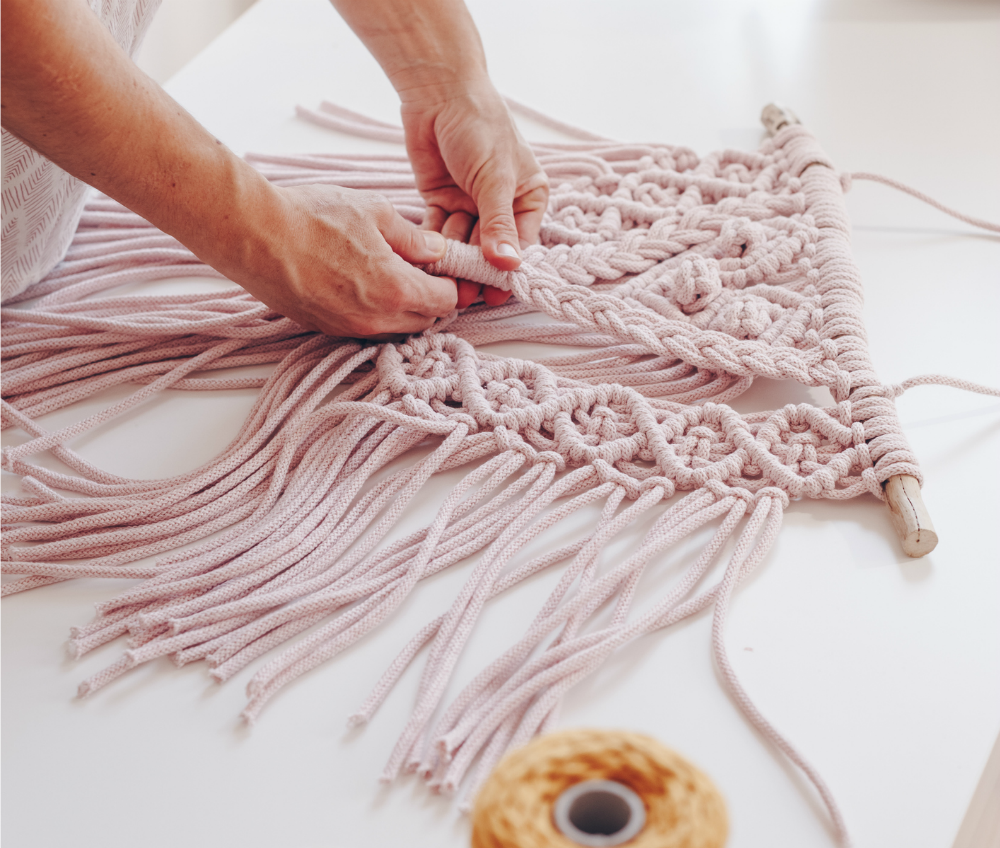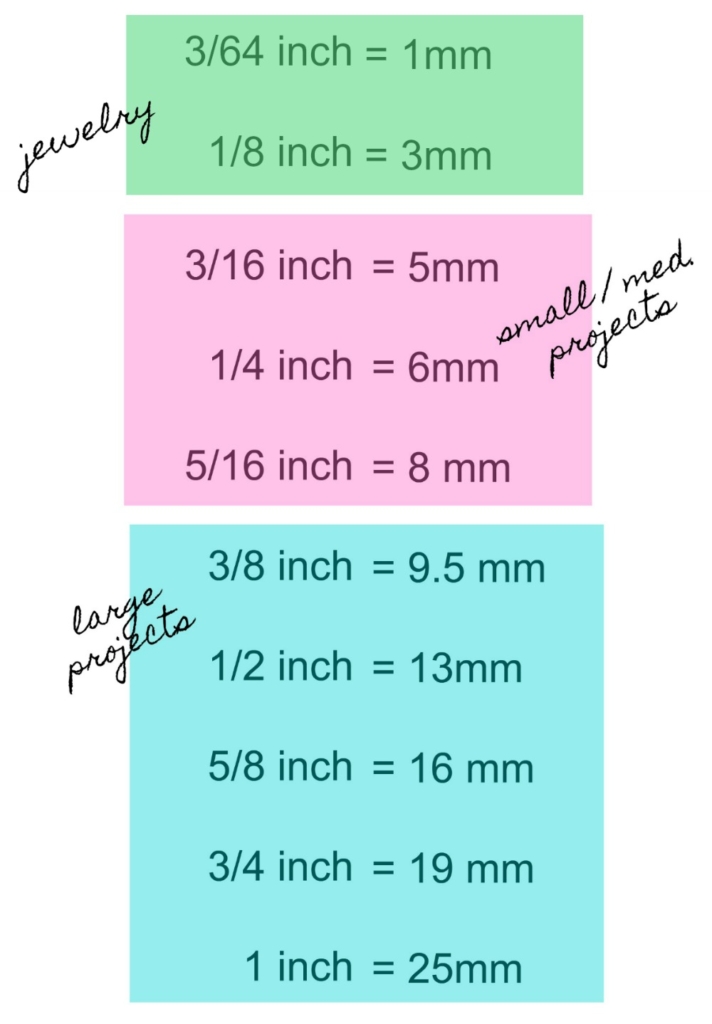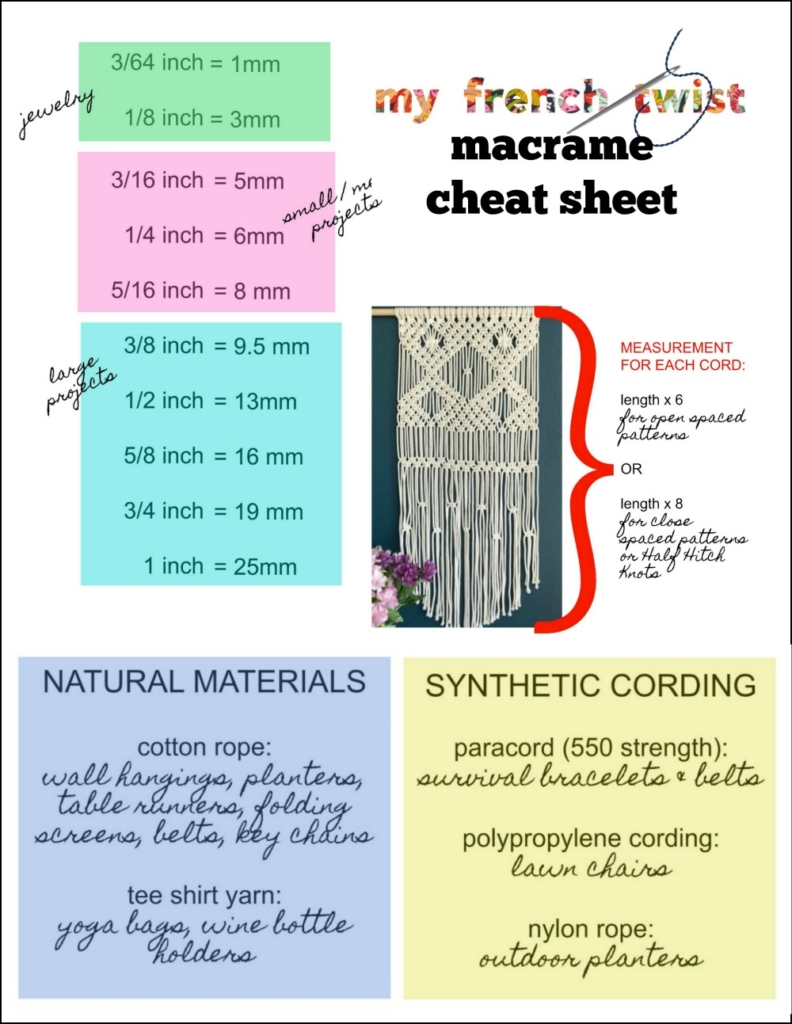If you’ve tried your hand at macrame, you’ve already learned that there can often be a lot of guesswork involved, especially in determining rope lengths. Many times I’ve had to alter a macrame pattern midway through my project simply because I started to run short on rope. However, the beauty of this craft is that it’s easy to improvise and play around with different designs. Nonetheless, this cheat sheet I’ve compiled may help when planning your next macrame project.
(This post may contain affiliate links; as an Amazon associate I earn from qualifying purchases. See disclosure here.)
rope width
The diameter of the rope or cording you use will directly impact the look of your project. Below are some general guidelines (from small to large):
- Cording with a diameter of 3mm or 4mm is a suitable size for macrame belts, key chains, and other small items.
- Tee shirt yarn is relatively thin and lightweight. It is perfect for items needing a bit of stretch, such as yoga bags and wine bottle holders.
- 3/16″ diameter rope, also known as clothesline rope, is the most versatile choice. This size works well for a wide range of macrame projects, such as hanging planters, table runners, placemats, market bags, small to medium wall hangings, and even folding screens.
- Oversized wall hangings are impressive and owe much of their appeal to the large diameter rope used. 3/8″ to 1/2″ rope works nicely but can be quite heavy. I’m still on the hunt for a lighter weight alternative.
Note: rope diameter is sold in either millimeters or inches. The chart below may prove helpful.
rope material
Below is a list of the most common types of rope used for macrame projects. But that doesn’t mean you can’t think outside of the box. In fact, I have a very large wall hanging in the works woven with chunky yarn instead of rope! So use this as a guide, but don’t be afraid to be adventurous.
- Natural materials, such as cotton, wool and hemp work best for indoor projects. Cotton rope is my favorite for most items, such as wall hangings, table runners and belts.
- Synthetic materials are a good choice for outdoor projects. I like paracord for survival bracelets and belts; and I use polypropylene for lawn chairs.
rope behavior
Yes, there is such a thing as rope behavior, especially when it comes to fraying.
- Braided cord is commonly sold at hardware and craft stores. While it is strong, it is sometimes difficult to knot and to fray, especially if it contains some synthetic fibers. Definitely not a good choice for creating tassels and fringe.
- Twisted cotton cord, such as 3-ply or 3-strand, is best for fringe. It unravels easily and adds a fun texture to your macrame project.
Also, to keep cords from unraveling while weaving a new project, first treat the ends. Synthetic cords can be treated by lighting the tip with a match to cause the end to melt. Cotton cords should be taped with masking or painters’ tape.
rope length
What length rope should I use for a project? This, my friend, is the million dollar question. Unfortunately, I don’t have a guaranteed formula for determining cord length, but I’ll share my personal guideline. If the macrame design uses doubled cords folding in half to form 2 cords (Lark’s Head Knots), then the rope pieces should be 8 times the length of the finished piece. This is true especially if the project has less open space and consists of knots that require lots of cording, such as Half Hitch Knots. If the piece uses lots of open spaces and less closed spaces, then 6 times the finished length is the rule. To download a printable version of the cheat sheet below, click here.
The biggest compliment is a little share – please pin the photo below!








I love your easy to follow instructions and tips…I’m so happy I found you.
thank you!
When I was younger, I used to do all kinds of macrame art and hangers. This took me back to those days. I see where getting back into this could be a benefit in upgrading our new yard. Thanks for sharing the knowledge.
I’m returning to macrame after a forty-year hiatus. Thanks for so much good information and beginner projects.
So glad you stopped by!